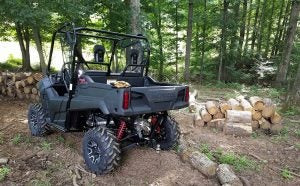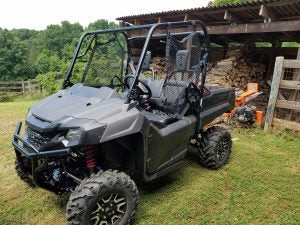For those of us with land that’s anything but manicured, the need for a reliable and rugged utility vehicle (UTV) is paramount. Forget neat, tidy, or flat – we’re talking about navigating deadfall, steep inclines, and uneven terrain. When the Honda Pioneer 700 arrived for testing, the question wasn’t about fancy features, but pure, unadulterated utility. This review dives deep into the Pioneer 700 to see if it lives up to the demands of real-world, tough conditions.
My first test for any UTV is always firewood duty. Hauling freshly cut wood to the shed is the perfect way to evaluate suspension, off-road handling, balance, and overall frame robustness. Right away, before even turning the key, two aspects of the Pioneer 700 stood out, hinting at its capabilities.
Firstly, the stock Blackstone HP-007 25×10.00-12 OTR tires. These weren’t your average, mild-mannered tires. They were noticeably more aggressive than what I’ve experienced on other utility vehicles. While such rugged tires might be overkill for pristine lawns or paved surfaces, that’s simply not the environment where this machine is meant to excel. The Pioneer 700 is built for tackling holes, climbing over obstacles, and navigating tricky, uneven terrain where solid grip is non-negotiable. These tires inspired confidence from the get-go.
Secondly, the 10.7 inches of standard ground clearance is a game-changer. This clearance perfectly complements the aggressive tires, ensuring that you’re not constantly worried about scraping the undercarriage. Even when maneuvering over steep inclines and uneven ground, the Pioneer 700 offered impressive mobility and peace of mind. It felt like it was built to go where you needed it to, without hesitation.
 Honda Pioneer 700 tackling tough terrain
Honda Pioneer 700 tackling tough terrain
Versatility is key for anyone who uses a UTV for a variety of tasks, not just one specific job. In my experience, the Pioneer 700 truly shines in this area.
The 1,000-pound capacity bed is a major asset. While I rarely pushed it to its absolute limit, hauling wood, concrete blocks, tools, and various materials was effortlessly handled. The tilt bed, equipped with a hydraulic assist strut, made unloading a breeze, saving time and back strain. This feature alone makes everyday tasks significantly easier.
While the Pioneer 700 is certainly capable on pavement, its heart lies in off-road performance. I briefly tested it on paved roads, reaching around 30 mph (the listed top speed is 45 mph, but my local roads are too winding to safely reach that). However, it’s clear that pavement isn’t its primary domain – rugged trails and work sites are where it truly belongs.
Towing capacity is another crucial aspect of a utility vehicle. The Pioneer 700 boasts a 1,500-pound towing capacity, and it effortlessly hauled my 650-pound log splitter using the 2-inch hitch. While my horse trailer is beyond its safe towing limit, the log splitter test demonstrated its ability to handle substantial loads with ease. For typical farm, ranch, or property maintenance tasks, the towing capability is more than sufficient.
These are the kinds of everyday tasks the Pioneer 700 is designed for, and it handled them all with competence and ease. Positioned in the middle of Honda’s Pioneer lineup, between the 500 and 1000 models, the 700 strikes a compelling balance. It’s not as compact as the 500, nor as powerful as the 1000, but it perfectly blends robust capability with manageable size, making it ideal for a wide range of users.
 Honda Pioneer 700 bed with wood
Honda Pioneer 700 bed with wood
One feature that adds to the driving experience is the ability to switch between automatic and manual transmission on the fly, using steering column-mounted paddle shifters. This is a fantastic addition for those who enjoy a more engaging driving experience or need more control in specific situations. For someone like me, who appreciates versatility and enjoys both practical work and recreational riding, this feature is a definite plus.
For those interested in the technical specifications, here are the key highlights of the Pioneer 700:
- Engine Type: 675cc liquid-cooled OHV single-cylinder four-stroke
- Fuel System: Fuel Injection (PGM-FI), 40mm throttle body
- Ignition: Electronic advance, full-transistorized type
- Transmission: Automotive-style automatic with hydraulic torque converter, 3 forward gears and Reverse. 2WD, 4WD, and 4WD with Differential lock modes. AT/MT modes with paddle shifters on Deluxe models.
- Driveline: Direct front and rear driveshafts
- Front Suspension: Independent double-wishbone; 7.9 inches travel
- Rear Suspension: Independent double-wishbone; 9.1 inches travel
- Dimensions (L/W/H): 114.7 inches, 59.7 inches, 77.6 inches
- Wheelbase: 76.8 inches
- Bed Capacity: 1,000 pounds
- Towing Capacity: 1,500 pounds
- Ground Clearance: 10.7 inches
- Turning Radius: 14.8 feet
- Curb Weight: 1,268 pounds (including fluids and full fuel tank)
- Fuel Capacity: 7.9 gallons (including 1.2-gallon reserve)
Beyond its core capabilities, the Pioneer 700 offers a wide array of accessories to further enhance its utility and customization. The extensive list includes a bed extender, cab-frame cargo bag, under-dash storage, fabric doors, auxiliary lights, brush guard, floor mats, storage covers, and even additional cup holders. This level of accessory support allows owners to tailor the Pioneer 700 to their specific needs and preferences, further solidifying its position as a truly versatile machine.
In conclusion, the Honda Pioneer 700 proves to be a highly capable and versatile UTV. Its robust tires and generous ground clearance make it well-suited for challenging terrain, while its bed and towing capacity handle everyday utility tasks with ease. The option for manual paddle shifting adds an element of driver engagement that’s appreciated by those who enjoy a more hands-on experience. For landowners, farmers, and anyone needing a reliable and adaptable UTV for work and play, the Honda Pioneer 700 is certainly worth serious consideration. When looking at Honda Pioneer Reviews, the 700 consistently stands out as a strong contender in the mid-size UTV category.
